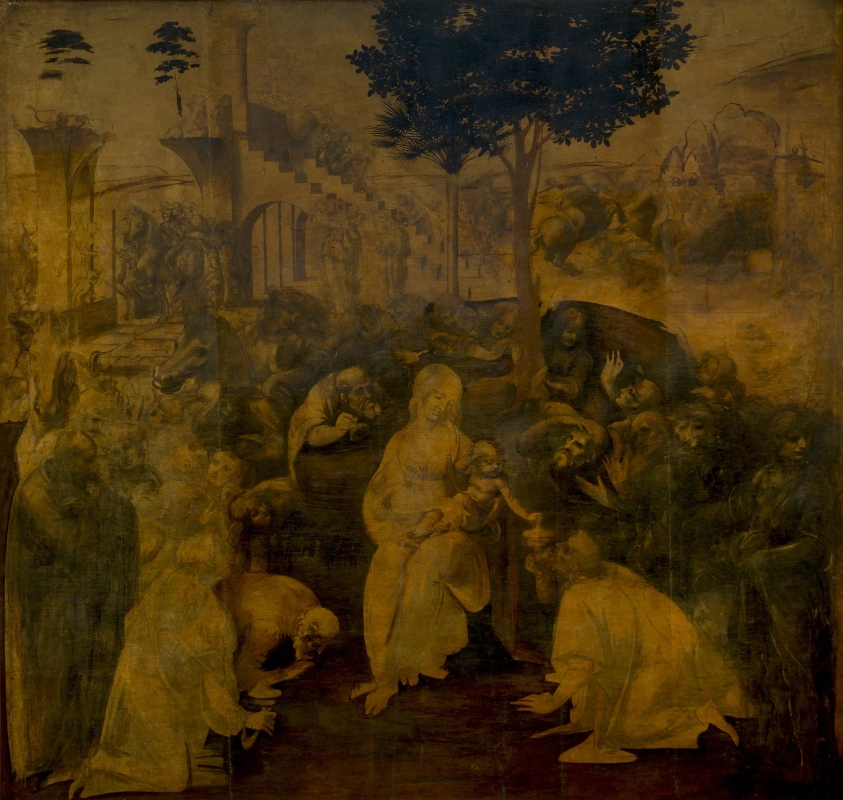log in
Enter site
Login to use Arthive functionality to the maximum
对贤士的崇拜
Leonardo da Vinci • 绘画, 1481, 246×243 厘米












画作描述 «对贤士的崇拜»
像达芬奇的其他作品一样, “魔法师的崇拜” (1481)被许多秘密和猜想所笼罩。这是最早的作品之一:在创作时,这位画家只有29岁。木制面板大约有两平方米半,用于索佩托的圣多纳托教堂的主祭坛,但达·芬奇未经过奥古斯丁修士的命令就前往佛罗伦萨前往米兰。他们花了15年的时间将其转让给另一位艺术家-Filippino Lippi, 他的版本 1496年的《贤士的崇拜》。
达·芬奇(Da Vinci)从波提切利(Botticelli)那里借用了祭坛的一般材料, 图片 根据几年前的福音故事无论是否巧合,人们都认为莱昂纳多作品中最右边的人物可能是艺术家本人的自画像,就像波提切利画中同一位置的人物也被认为是他的自画像一样。
此外,这两部作品均以稳定的金字塔构图基础和极富个性的人物组合在一起。但是,与Botticelli作品的几乎是幽闭恐怖的气氛不同,达芬奇的画板的特点是高视线,这大大增加了空气。即使在主要动作的背景下出现了一些背景场景。
通常,图片的气氛与通常由基督诞生的情节引起的联想没有什么相似:一个安静的繁星点点的夜晚,伯利恒的星星在天空中,指引着通往贤士的道路,这位贤士是一个谦虚的马and。尽管达芬奇在撰写《魔术师的崇拜》时,确实有一些不同的图标绘画传统(1。 2。 3),但即使如此,面板上仍然发生了太多事情:看来您即将开始听到数十种声音的嗡嗡声。
在人和马的混乱之中,两棵树静态地上升,使风雨如磐的构图秩序化并搁浅:一棵棕榈树和一个角豆树。植物的象征意义是相当透明的。棕榈树与福音有关,当它的树枝为耶稣钉十字架时,耶稣在十字架上钉死前一周乘驴进入耶路撒冷。就像月桂树一样,这棵树标志着胜利者的胜利:也就是说,基督的诞生意味着基督教战胜了异教徒信仰。
长期以来,人们一直认为角豆树果实的重量始终是恒定的,因此可以将其用作衡量体重的原因。因此,对于特别珍贵的东西,例如宝石,珠宝或金属,该植物象征着最高的王权,回想起圣经中基督是万王之王的话。
背景中还有另外两棵相似的树,它们只有很小的,很小的,生长在一座古庙的废墟上。它最常被解释为异教主义即将结束的象征(而棕榈树和角豆树只会增强这种象征主义)。但是,一些研究人员认为这座建筑不仅仅是废墟。
在本世纪初,毛里齐奥·塞拉西尼(Maurizio Seracini)对达芬奇的《贤士的崇拜》进行了广泛的研究。在红外辐射的帮助下,他拍摄了近两千半的照片,这使得他有可能看到艺术家的原始想法,并将其隐藏在油漆的上层之下。根据塞拉西尼(Seracini)的说法,实际上是达芬奇完成面板上的工作至少半个世纪之后,又由不是才华横溢的其他人使用。
因此,在这些图片中,失踪的公牛和驴子与谷仓的部分屋顶一起出现,其中一位魔术师的脸在维尔京女神的右肩上扭曲了一个怪异的鬼脸,最初充满了威严与安宁。背景中的两名骑兵实际上是一场全面的马术比赛的参与者,在被毁建筑物的楼梯上发现了建造者,从事重建工作。
Seracini声称,在达芬奇的原始绘画中,古庙建筑与古埃及建筑之间的相似性显而易见。首都的设计-圆柱的上部以莲花的形式表明了这一点。研究人员认为,这位画家的意图是表明异教徒庇护所正在按照古埃及模式重建为新的结构。
阴谋论的拥护者欣然接受了这一版本,以证实丹·布朗的著作《达芬奇密码》中描述的阴谋论。根据该书,达芬奇是圣殿骑士团的成员,并保留了他们关于基督后裔的古老秘密。据称,原始秩序解散后,实际上是秘密重建的,它应象征“贤士的崇拜”上的神秘建筑。但是塞拉西尼在2005年接受《卫报》采访时拒绝了这种假设,并说他从未读过布朗的书。
作者:Natalia Azarenko
达·芬奇(Da Vinci)从波提切利(Botticelli)那里借用了祭坛的一般材料, 图片 根据几年前的福音故事无论是否巧合,人们都认为莱昂纳多作品中最右边的人物可能是艺术家本人的自画像,就像波提切利画中同一位置的人物也被认为是他的自画像一样。
此外,这两部作品均以稳定的金字塔构图基础和极富个性的人物组合在一起。但是,与Botticelli作品的几乎是幽闭恐怖的气氛不同,达芬奇的画板的特点是高视线,这大大增加了空气。即使在主要动作的背景下出现了一些背景场景。
通常,图片的气氛与通常由基督诞生的情节引起的联想没有什么相似:一个安静的繁星点点的夜晚,伯利恒的星星在天空中,指引着通往贤士的道路,这位贤士是一个谦虚的马and。尽管达芬奇在撰写《魔术师的崇拜》时,确实有一些不同的图标绘画传统(1。 2。 3),但即使如此,面板上仍然发生了太多事情:看来您即将开始听到数十种声音的嗡嗡声。
在人和马的混乱之中,两棵树静态地上升,使风雨如磐的构图秩序化并搁浅:一棵棕榈树和一个角豆树。植物的象征意义是相当透明的。棕榈树与福音有关,当它的树枝为耶稣钉十字架时,耶稣在十字架上钉死前一周乘驴进入耶路撒冷。就像月桂树一样,这棵树标志着胜利者的胜利:也就是说,基督的诞生意味着基督教战胜了异教徒信仰。
长期以来,人们一直认为角豆树果实的重量始终是恒定的,因此可以将其用作衡量体重的原因。因此,对于特别珍贵的东西,例如宝石,珠宝或金属,该植物象征着最高的王权,回想起圣经中基督是万王之王的话。
背景中还有另外两棵相似的树,它们只有很小的,很小的,生长在一座古庙的废墟上。它最常被解释为异教主义即将结束的象征(而棕榈树和角豆树只会增强这种象征主义)。但是,一些研究人员认为这座建筑不仅仅是废墟。
在本世纪初,毛里齐奥·塞拉西尼(Maurizio Seracini)对达芬奇的《贤士的崇拜》进行了广泛的研究。在红外辐射的帮助下,他拍摄了近两千半的照片,这使得他有可能看到艺术家的原始想法,并将其隐藏在油漆的上层之下。根据塞拉西尼(Seracini)的说法,实际上是达芬奇完成面板上的工作至少半个世纪之后,又由不是才华横溢的其他人使用。
因此,在这些图片中,失踪的公牛和驴子与谷仓的部分屋顶一起出现,其中一位魔术师的脸在维尔京女神的右肩上扭曲了一个怪异的鬼脸,最初充满了威严与安宁。背景中的两名骑兵实际上是一场全面的马术比赛的参与者,在被毁建筑物的楼梯上发现了建造者,从事重建工作。
Seracini声称,在达芬奇的原始绘画中,古庙建筑与古埃及建筑之间的相似性显而易见。首都的设计-圆柱的上部以莲花的形式表明了这一点。研究人员认为,这位画家的意图是表明异教徒庇护所正在按照古埃及模式重建为新的结构。
阴谋论的拥护者欣然接受了这一版本,以证实丹·布朗的著作《达芬奇密码》中描述的阴谋论。根据该书,达芬奇是圣殿骑士团的成员,并保留了他们关于基督后裔的古老秘密。据称,原始秩序解散后,实际上是秘密重建的,它应象征“贤士的崇拜”上的神秘建筑。但是塞拉西尼在2005年接受《卫报》采访时拒绝了这种假设,并说他从未读过布朗的书。
作者:Natalia Azarenko


